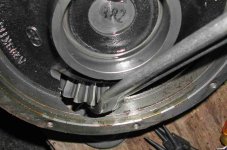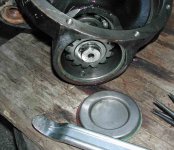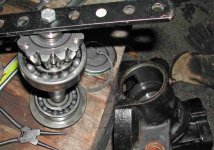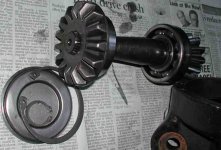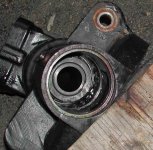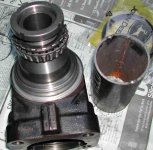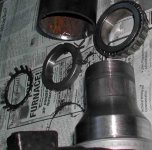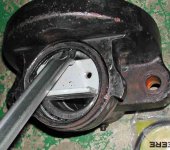dfkrug
Super Member
- Joined
- Feb 3, 2004
- Messages
- 7,188
- Location
- Santa Cruz Mtns, CA
- Tractor
- 05 Kioti CK30HST w/ Prairie Dog backhoe, XN08 mini-X
Now I need to remove the kingpin.
This MFWD system requires the removal of the kingpin housing end cap
to get the kingpin out. Some systems let you get it apart from above,
where the bevel gear connects to the top of the kingpin.
To remove the end cap, this tractor does not provide any "cheater slot"
on the outside to get a screwdriver in there, so you need to push from the
inside. The first photo shows me using a tire iron against the bevel gear
that drives the hub ring gear. Hopefully the bottom of the housing is free
of dents from rock incursions. Mine was fine, and it came off easily.
In the 2nd photo, you see the cap, just removed. The bevel gear has a
small snap ring and it comes right out. You can see the end of the kingpin.
Notice the hole in the end? It is threaded and I will need it for the next
step. After the bevel gear is out, there is a large snap ring about 4 inches
down inside the housing. This was very tough to remove.
The third photo shows part of how it did it, with the removed snap ring.
Once the installed snap ring is partially retracted (with pry bars), I needed
some way to pull on the kingpin. That is what the bar and bolt did for me.
The bolt was threaded into the hole, and it put just enough upward force on
the snap ring to allow it to come out. I don't know how clear my
explanation is, but it sure goes in a lot easier!
Finally, there is my kingpin. Very beefy, but a little corrosion on it. The
gears are not noticably warn, and all the rest of the bearings are OK.
I still don't have access to the last seal....that is the last step (next).
This MFWD system requires the removal of the kingpin housing end cap
to get the kingpin out. Some systems let you get it apart from above,
where the bevel gear connects to the top of the kingpin.
To remove the end cap, this tractor does not provide any "cheater slot"
on the outside to get a screwdriver in there, so you need to push from the
inside. The first photo shows me using a tire iron against the bevel gear
that drives the hub ring gear. Hopefully the bottom of the housing is free
of dents from rock incursions. Mine was fine, and it came off easily.
In the 2nd photo, you see the cap, just removed. The bevel gear has a
small snap ring and it comes right out. You can see the end of the kingpin.
Notice the hole in the end? It is threaded and I will need it for the next
step. After the bevel gear is out, there is a large snap ring about 4 inches
down inside the housing. This was very tough to remove.
The third photo shows part of how it did it, with the removed snap ring.
Once the installed snap ring is partially retracted (with pry bars), I needed
some way to pull on the kingpin. That is what the bar and bolt did for me.
The bolt was threaded into the hole, and it put just enough upward force on
the snap ring to allow it to come out. I don't know how clear my
explanation is, but it sure goes in a lot easier!
Finally, there is my kingpin. Very beefy, but a little corrosion on it. The
gears are not noticably warn, and all the rest of the bearings are OK.
I still don't have access to the last seal....that is the last step (next).
